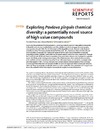Identificador persistente para citar o vincular este elemento:
https://accedacris.ulpgc.es/handle/10553/69387
| Campo DC | Valor | idioma |
|---|---|---|
| dc.contributor.author | Fernandes, Tomásia | en_US |
| dc.contributor.author | Martel, Antera | en_US |
| dc.contributor.author | Cordeiro, Nereida | en_US |
| dc.date.accessioned | 2020-01-25T06:08:22Z | - |
| dc.date.available | 2020-01-25T06:08:22Z | - |
| dc.date.issued | 2020 | en_US |
| dc.identifier.issn | 2045-2322 | en_US |
| dc.identifier.other | Scopus | - |
| dc.identifier.uri | https://accedacris.ulpgc.es/handle/10553/69387 | - |
| dc.description.abstract | To uncover the potential of Pavlova pinguis J.C. Green as a natural source of value added compounds, its lipophilic extracts were studied before and after alkaline hydrolysis using gas chromatography-mass spectrometry (GC-MS). The GC-MS analysis of the lipophilic extracts showed a wide chemical diversity including 72 compounds distributed by fatty acids (29), sterols (14), fatty alcohols (13) and other lipophilic compounds (16). Fatty acids represented the main class of identified compounds presenting myristic, palmitic, palmitoleic and eicosapentaenoic acids as its main components. Through the ∑ω6/∑ω3 ratio (0.25) and sterol composition it was possible to observe that P. pinguis is a valuable source of ω3 fatty acids and stigmasterol (up to 43% of total sterols). After alkaline hydrolysis, fatty acids and fatty alcohols content increased by 32 and 14% respectively, in contrast to, monoglycerides which decreased by 84%. The long chain alcohols content enables the exploitation of this microalga as a source of these bioactive compounds. Smaller amounts of sugars and other compounds were also detected. The present study is a valuable reference to the metabolite characterization of P. pinguis and shows the potential of this microalga for nutraceutical and pharmaceutical industries. | en_US |
| dc.language | eng | en_US |
| dc.relation.ispartof | Scientific Reports | en_US |
| dc.source | Scientific reports [ISSN 2045-2322], v. 10 (1), p. 339 | en_US |
| dc.subject | 241705 Biología marina | en_US |
| dc.subject | 241707 Algología (ficología) | en_US |
| dc.subject.other | Pavlova pinguis | en_US |
| dc.title | Exploring Pavlova pinguis chemical diversity: a potentially novel source of high value compounds | en_US |
| dc.type | info:eu-repo/semantics/article | en_US |
| dc.type | Article | en_US |
| dc.identifier.doi | 10.1038/s41598-019-57188-y | en_US |
| dc.identifier.scopus | 85077941014 | - |
| dc.contributor.authorscopusid | 57202652497 | - |
| dc.contributor.authorscopusid | 57213671622 | - |
| dc.contributor.authorscopusid | 7004319456 | - |
| dc.description.lastpage | 339 | - |
| dc.identifier.issue | 1 | - |
| dc.description.firstpage | 339 | - |
| dc.relation.volume | 10 | - |
| dc.investigacion | Ciencias | en_US |
| dc.type2 | Artículo | en_US |
| dc.utils.revision | Sí | en_US |
| dc.identifier.ulpgc | Sí | es |
| dc.description.sjr | 1,24 | |
| dc.description.jcr | 4,379 | |
| dc.description.sjrq | Q1 | |
| dc.description.jcrq | Q1 | |
| dc.description.scie | SCIE | |
| item.grantfulltext | open | - |
| item.fulltext | Con texto completo | - |
| crisitem.author.dept | GIR IOCAG: Oceanografía Biológica y Algología Aplicada | - |
| crisitem.author.dept | IU de Oceanografía y Cambio Global | - |
| crisitem.author.orcid | 0000-0002-7450-0505 | - |
| crisitem.author.parentorg | IU de Oceanografía y Cambio Global | - |
| crisitem.author.fullName | Martel Quintana, Antera De Jesús | - |
| Colección: | Artículos | |
Citas SCOPUSTM
20
actualizado el 08-jun-2025
Citas de WEB OF SCIENCETM
Citations
19
actualizado el 08-jun-2025
Visitas
208
actualizado el 31-may-2025
Descargas
193
actualizado el 31-may-2025
Google ScholarTM
Verifica
Altmetric
Comparte
Exporta metadatos
Los elementos en ULPGC accedaCRIS están protegidos por derechos de autor con todos los derechos reservados, a menos que se indique lo contrario.
